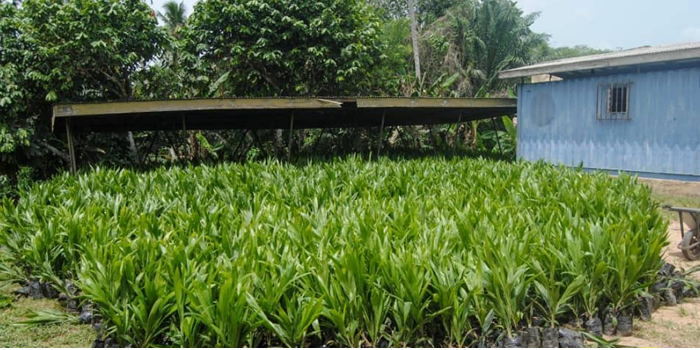

The District Health Directorate (DHD), with its appropriate structures, has the responsibility to plan and deliver Health care in the Ajumako-Enyan-Essaim District. The District strategically combines curative and preventive methods to provide quality primary health care to its people at three different levels – the community level, Sub district level and the District level. At each level, there are various categories of health care providers that assist the DHMT. To ensure effective supervision of health delivery, the district health directorate has been divided into four Health Sub-districts. These are Abaasa, Bisease, Ajumako, Nkwantanum and Sonkwaa Sub-districts.
The district has one hospital located at Ajumako. It is accessible to many communities and provides health care services to the people of the district and others from outside the district. Other health facilities providing health services in the district comprise of community clinics, CHPS Zones and Private Maternity Homes. Statistics on health facilities and service providers in the Ajumako Enyan-Essiam District is presented in table below.
Table 25: Health Facilities.
Source: Ajumako-Enyan-Essiam District Health Directorate Annual Report 2016
Figure 13: Ajumako-Enyan-Essiam District Map with Health Facilities
Source: Ajumako-Enyan-Essiam District Health Directorate Annual Report 2016
Table 26: Functional CHPS in the District as at 2017 July
Three (3) new CHPS compound in have been made functional in Abeka, Nyamebekyere and Estii fawomanye
Figure 14: functional CHPS Source: Ajumako-Enyan-Essiam District Health Directorate –report 2016
Health Status of the District
Although there has been general improvement in the health conditions of the people in the Ajumako-Enyan-Essiam District, malaria continues to be the fundamental cause of ill health. Acute Upper Respiratory Infections, skin diseases, diarrhoea, hypertension, rheumatism, anaemia and enteric fever are some of the top most registered diseases prevailing in the district per the 2016 DHMT records. Sexually transmitted infections (STIs), HIV/AIDS among the younger generation as well as teenage pregnancy and low supervised delivery are of great concern.
One of the health challenges is the high teenage pregnancy which has seen increased over the past three years. Out of the total of 4046 pregnant women who registered in 2016, 717 representing 17.7% were adolescents as compared to 744 representing 18.1% in 2015. In the year under review, teenage pregnancy decreased by 0.4%. The district therefore should strengthen adolescent health intervention and health education to curb this situation.
Generally, the nutrition of the people, depends on the food crops produced locally. However, the nutritional status of children in the district is low and characterized by severe malnutrition and anaemia. Common forms of malnutrition seen in the district are kwashiorkor and marasmus. Mothers of malnourished children are given nutritional counselling and the severely malnourished children admitted onto the community-based management of acute malnutrition (CMAM) programme.
programme. Radio talk shows are organized regularly to educate community members on malnutrition, its causes and treatment. Water supply, sanitation and waste disposal passes for an emerging problem threatening the health status of a major community in the district such as Ajumako.
Most of the communities do not have a refuse dumping site and a final waste disposal site. The situation in Ajumako (district capital) can be described as critical since it is the most populous town in the district. Most inhabitants do not have toilet facilities in their homes and tend to defecate in the bush and on refuse dumps.
Thus, poor sanitation in the area is of major concern despite numerous health education activities; behavioural change has woefully been insignificant. Emanating from this quagmire are the main health problems such as diarrhoea, skin infections, malnutrition, high incidence of enteric fever and infant mortality rates
The table below shows details of major health concerns in the district:
Table 27: Health concerns
Source: Ghana Health Service
Human Resource
The staffing situation in the district has stabilized somehow although some critical staff are still needed. This was because of proper human resource planning. The district continuously forwarded staff requirement to the region for the necessary action to be taken. There was also a follow-up on correspondence sent to region and national.
Table 28: The table below reveals the strength of some critical staff of district
Source: Ghana Health Service
The staff strength was supported by students on practical, national service, and industrial attachment. As part of effort to address payroll issues, the Human Resource Unit transferred all newly employed staff including those transferred in onto the district’s payroll. There was also prompt deletion of demised staff, staff who have vacated post and staff on retirement from the payroll. Staffs who have been transferred from the district were encouraged to transfer their names to their new stations payroll. The nominal roll was updated all the time. Promotion issues were also not left out. An attempt was made to ensure that staffs due for promotion were duly promoted.
To ensure sanity among the workforce, the district health directorate established a disciplinary committee that resolve grievances among staff. The committee sat twice in 2016 to settle disputes that arose between subordinates - superiors. Some insubordinates staff was issued with verbal warnings and query letters to bring them to order.
HIV /AIDS
The Health Directorate and the Social Welfare Department are responsible for the coordination and the implementation of HIV/AIDS related activities in the district. Current strategies for combating the disease include a package of interventions to reduce HIV transmission, delivery of care and support services for PLWHA, delivery of information on HIV/AIDS for action and the provision of essential technical support to DAs and institutions in the district engaged in the fight against HIV/AIDS.
Interventions to Reduce HIV and STI Transmission
Activities including Prevention of Mother-To-Child Transmission (PMTCT), Voluntary Counselling and Testing (VCT) services as well as management of opportunistic infections are being carried out. In addition, promotion of condom use, know “Your Status” as well as screening of TB patients for HIV are some of the measures applied to curb the spread of the deadly disease in the district.
Key development issue
• High HIV/AIDS prevalence
• PLWA stigmatization
Teenage Pregnancy
Teenage pregnancy continues to be a menace in the district despite interventions put in place such as health education on community information centres and integrated family planning. Out of the total of 4046 pregnant women who registered in 2016, 717 representing 17.7% were adolescents. In the year under review, teenage pregnancy increased by 1.9%
Figure 15: ANC registrants and teenage pregnancy
The above chart indicates a reduction from 18.1% in 2015 to 17.7% in 2016. But in mid-2017, the teenage pregnancy prevalence has increased from 17.7% to 19.6%.
Date Created : 9/13/2024 2:33:11 AM










 facebook
facebook
 twitter
twitter
 Youtube
Youtube
 +233 593 831 280
+233 593 831 280 0800 430 430
0800 430 430 GPS: GE-231-4383
GPS: GE-231-4383 info@ghanadistricts.com
info@ghanadistricts.com Box GP1044, Accra, Ghana
Box GP1044, Accra, Ghana